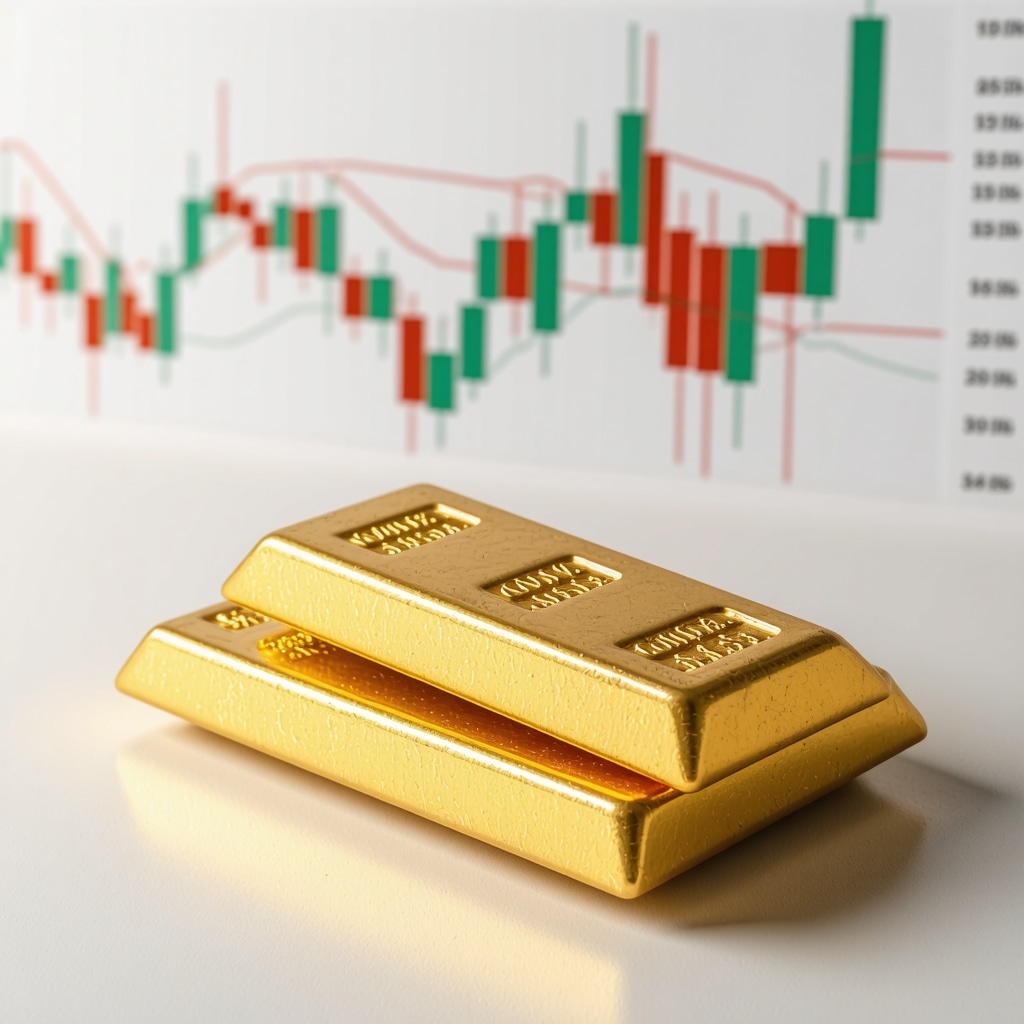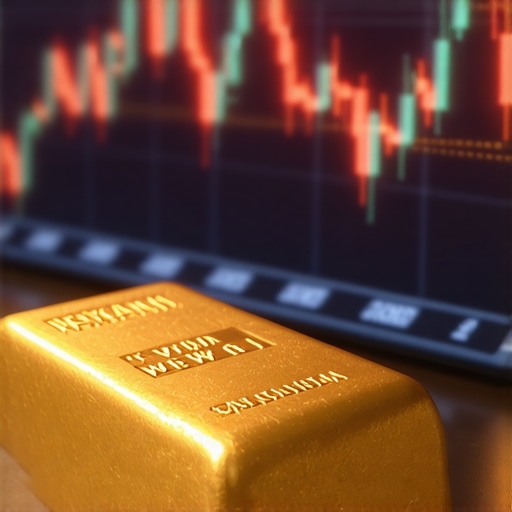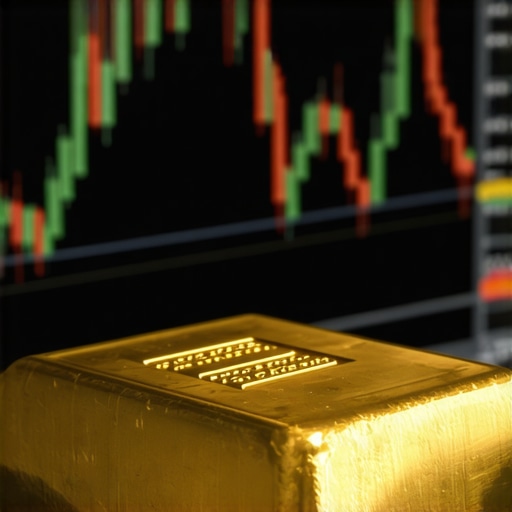Understanding Macroeconomic Forces Shaping Gold Price Forecast 2025
Gold’s price trajectory in 2025 will be intricately influenced by multifaceted macroeconomic factors, including persistent inflationary pressures, fluctuating interest rates, and geopolitical uncertainties. Experienced investors recognize that gold’s role as a safe-haven asset intensifies amid global economic instability, making it imperative to analyze central bank policies and currency valuations critically. The interplay between the U.S. dollar strength and gold prices remains a pivotal dynamic, where a weaker dollar typically buoy gold demand and pricing.
How Do Central Bank Gold Purchases Affect Market Dynamics and Price Volatility in 2025?
Central banks have increasingly adopted gold accumulation strategies to diversify reserves and hedge against systemic risks. Their purchasing patterns in 2025 are forecasted to directly impact liquidity and price volatility in the gold market. For instance, strategic acquisitions by emerging economies could tighten supply, triggering upward price momentum. According to the World Gold Council’s 2024 report, central bank buying surged by 60% year-over-year, underscoring a trend expected to persist into 2025 (World Gold Council).
Supply-Demand Imbalances: Analyzing Gold Mining Output Versus Growing Industrial and Investment Demand
Forecasting gold prices requires a nuanced understanding of supply constraints, particularly given the plateauing of gold mine production juxtaposed with rising demand from technology sectors and investment vehicles like ETFs. Mining output growth is hindered by resource depletion and geopolitical risks in key producing regions, which could exacerbate supply shortages. Concurrently, innovations in electronics and renewable energy sectors are creating incremental gold demand, further tightening the supply-demand equilibrium.
Strategic Investment Approaches Amid Volatile Gold Market Conditions
Investors must refine portfolio strategies to optimize returns in 2025’s volatile market environment. Diversification across physical gold, mining stocks, and financial instruments such as ETFs or mutual funds can mitigate risk while capturing growth. Sophisticated trading techniques, including leveraging technical analysis and timing market entry based on macroeconomic indicators, are essential. For detailed methodologies, see our expert guide on mastering gold trading techniques for 2025.
Integrating Gold into Inflation-Hedging Portfolios: A Professional Perspective
Given gold’s historic efficacy as an inflation hedge, investors are advised to calibrate their exposure based on inflation outlooks and monetary policy shifts. Allocating a strategic percentage of assets to gold can preserve purchasing power and reduce portfolio volatility. The growing complexity of inflation dynamics in 2025 necessitates a dynamic approach to gold investment, balancing between physical holdings and paper gold instruments.
Explore More Expert-Level Analysis and Share Your Insights
For investors seeking to deepen their understanding of gold price movements and effective investment strategies, exploring comprehensive analyses on key influencers driving gold prices in 2025 can provide critical advantages. We invite seasoned investors and analysts to contribute their perspectives and engage in ongoing discussions to enrich the collective expertise.
Decoding the Influence of Currency Fluctuations on Gold’s 2025 Outlook
Currency dynamics, especially the strength of the U.S. dollar, are pivotal in shaping gold prices. A depreciating dollar often results in higher gold prices as gold becomes cheaper for holders of other currencies, boosting demand. However, the nuanced relationship is influenced by global trade balances, interest rate differentials, and geopolitical tensions. Investors must track currency indices alongside gold market signals to anticipate price movements accurately. For a deeper dive into the currency-gold interplay, explore our analysis on key factors moving gold prices in 2025.
Evaluating Technological Innovations Impacting Gold Demand and Supply
The advent of cutting-edge technologies in electronics, medical devices, and renewable energy sectors is reshaping gold demand profiles. Innovations such as flexible electronics and advanced photovoltaic cells require gold’s unique conductive and corrosion-resistant properties, incrementally increasing industrial consumption. On the supply front, technological advancements in mining including automation and AI-driven exploration promise to optimize extraction efficiency but also raise cost considerations. Understanding these technological trends allows investors to anticipate shifts in gold’s supply-demand equilibrium and price trajectory more precisely.
What Role Will Environmental, Social, and Governance (ESG) Factors Play in Gold Mining and Investment in 2025?
ESG considerations are rapidly becoming a decisive factor in gold mining operations and investment strategies. Mining companies with strong ESG credentials tend to attract greater institutional investment and enjoy operational resilience. Conversely, those neglecting sustainability face regulatory scrutiny and reputational risks that can depress share prices. Investors should incorporate ESG metrics when selecting gold mining stocks or funds to ensure alignment with long-term value creation and risk management. The McKinsey & Company report on ESG in mining offers authoritative insights into this transformative trend.
Strategic Utilization of Derivatives and Hedging in the 2025 Gold Market
Advanced investors increasingly deploy derivatives such as futures, options, and ETFs to manage exposure and capitalize on gold price volatility. Hedging strategies can protect portfolios from downside risks in times of uncertainty, while speculative approaches may amplify gains if executed with precision. Mastering these instruments requires rigorous market analysis and an understanding of macroeconomic triggers impacting gold. For comprehensive guidance, our resource on smart gold trading techniques is indispensable.
Incorporating Gold in Multi-Asset Portfolios for Enhanced Risk-Adjusted Returns
Integrating gold into diversified portfolios enhances risk-adjusted returns by reducing volatility and providing a hedge against inflation and geopolitical shocks. Optimal allocation balances depend on individual risk tolerance, investment horizon, and macroeconomic outlook. Combining physical gold with ETFs and mining equities can offer liquidity alongside growth potential. For investors aiming to build resilient portfolios, reviewing our expert advice on building balanced gold ETF portfolios is highly recommended.
Join the Conversation and Share Your Advanced Strategies
We invite seasoned investors and industry experts to share their insights and strategies related to gold investing in 2025. Your contributions can enrich this expert discourse and assist the community in navigating complex market dynamics. Comment below or share this article with your network to foster informed investment decisions.
Leveraging Derivatives for Sophisticated Gold Market Engagement in 2025
In the volatile landscape of 2025 gold trading, derivatives such as futures, options, and swaps are indispensable tools for institutional and high-net-worth investors aiming to hedge risks or capitalize on price swings. Unlike traditional physical gold investment, derivatives offer enhanced liquidity and flexibility but demand a rigorous understanding of market signals and macroeconomic triggers. For example, utilizing options strategies like straddles or collars can provide downside protection while preserving upside potential amid uncertain inflation trends and geopolitical tensions. The interplay between derivatives positioning and spot gold prices often reveals subtle market sentiment shifts, which advanced traders exploit to anticipate trend reversals or breakouts.
Importantly, derivatives also facilitate arbitrage opportunities across global exchanges, enabling sophisticated players to optimize returns through cross-market price discrepancies. However, such strategies require robust risk management frameworks to mitigate exposure to counterparty and basis risks. As the 2025 gold market evolves, integrating algorithmic trading models that assimilate macroeconomic data, technical indicators, and sentiment analysis will increasingly differentiate successful traders from the rest.
How Can Advanced Derivative Strategies Be Optimized to Manage Gold Price Volatility Amid Inflationary and Geopolitical Uncertainty?
To optimize derivative strategies in 2025, investors must dynamically adjust their hedging ratios in response to shifting inflation expectations and central bank signals. For instance, as real interest rates fluctuate, the implied volatility of gold options tends to react, influencing premium costs and strategic positioning. Incorporating scenario analysis and stress testing can identify vulnerabilities and adaptive tactics, such as rolling futures contracts to maintain favorable exposure or employing volatility spreads to benefit from expected market turbulence. Additionally, cross-hedging with correlated assets like silver or mining equities can refine portfolio risk profiles.
Engagement with specialized research, such as the CME Group’s educational materials on gold futures and options, provides critical insights into contract specifications, margin requirements, and best practices for execution. Ultimately, mastering these derivative instruments involves continuous learning and adaptation to the evolving macroeconomic and geopolitical context.
ESG Integration: Elevating Gold Mining Investments to Meet 2025’s Sustainability Mandates
Environmental, Social, and Governance (ESG) factors have transcended from niche considerations to central pillars in evaluating gold mining ventures. In 2025, investors increasingly prioritize mining companies demonstrating leadership in sustainable resource management, carbon footprint reduction, and community engagement. These ESG attributes not only mitigate regulatory and reputational risks but also correlate with operational efficiencies and long-term value creation.
The challenge lies in the heterogeneous ESG reporting standards and the complexity of measuring impact in extractive industries. Advanced investors employ proprietary ESG scoring models that integrate third-party audits, satellite imagery for environmental monitoring, and social impact assessments. This comprehensive due diligence enables discerning capital allocation to companies poised to outperform amid tightening global sustainability regulations.
Moreover, green financing mechanisms, such as sustainability-linked bonds and ESG-themed ETFs, are shaping capital flows toward responsible mining initiatives. The McKinsey & Company report on ESG in mining elucidates how ESG integration is not only a compliance exercise but a strategic lever for competitive advantage and risk mitigation in 2025 and beyond.
Optimizing Multi-Asset Portfolios with Gold for Superior Risk-Adjusted Performance
Strategically embedding gold within multi-asset portfolios enhances diversification, particularly during periods of elevated inflation and market uncertainty. Advanced portfolio construction frameworks advocate for a calibrated blend of physical gold, mining equities, and gold-related derivatives to balance liquidity, growth potential, and risk mitigation. Quantitative models incorporating covariance matrices and factor analysis guide precise allocation decisions tailored to investor-specific risk tolerances and investment horizons.
Dynamic rebalancing strategies, responsive to evolving macroeconomic indicators such as real interest rates, inflation surprises, and currency fluctuations, further optimize portfolio resilience. Additionally, integrating alternative data sources—like satellite tracking of mining activity or social sentiment analytics—can provide early signals to fine-tune exposure. Investors should also consider the tax implications and cost structures associated with various gold investment vehicles to maximize net returns.
For those seeking actionable frameworks, our detailed expert resource on building balanced gold ETF portfolios offers nuanced guidance blending theory with practical execution.
Join the Expert Dialogue: Share Your Strategies and Insights on Gold Investment in 2025
The gold investment landscape in 2025 is complex and rapidly evolving, demanding continuous exchange of advanced strategies and real-world experiences. We encourage seasoned investors, analysts, and strategists to contribute their perspectives in the comments or via our expert forums. Your insights can illuminate emerging trends, refine investment paradigms, and empower the community to navigate the nuanced gold market effectively. Engage with us and elevate the collective expertise to master this dynamic asset class.
Harnessing Quantitative Models for Predictive Gold Price Analytics
In 2025, the application of sophisticated quantitative models—incorporating machine learning algorithms and big data analytics—has become paramount for forecasting gold price movements with greater precision. These models integrate heterogeneous data sets, including macroeconomic indicators, geopolitical event probabilities, and market sentiment metrics derived from alternative data sources such as social media and satellite imagery. By calibrating predictive analytics with real-time inputs, investors can identify subtle inflection points and volatility regimes that traditional analysis might overlook, enabling proactive positioning in gold markets.
Exploring Blockchain and Tokenization’s Impact on Gold Liquidity and Accessibility
The advent of blockchain technology and the tokenization of gold assets is revolutionizing market liquidity and democratizing access to physical gold investments. Tokenized gold allows fractional ownership and instantaneous settlement, reducing counterparty risks and enhancing transparency across the value chain. Institutional investors benefit from increased market depth, while retail participants gain exposure through decentralized platforms, broadening the investor base. Understanding the regulatory landscape governing digital gold tokens is critical as compliance frameworks evolve globally, affecting market adoption trajectories.
How Are Blockchain-Based Gold Tokens Influencing Market Efficiency and Price Discovery in 2025?
Blockchain-enabled gold tokens facilitate more efficient price discovery by enabling real-time trading and settlement with minimal intermediaries, thus narrowing bid-ask spreads and enhancing market transparency. Additionally, the immutable nature of blockchain records fortifies provenance verification, mitigating fraud risks. These features contribute to improved liquidity and price responsiveness, particularly in volatile environments. However, challenges such as regulatory uncertainty and cybersecurity vulnerabilities require careful navigation by investors and issuers alike. For an in-depth exploration, the Investopedia article on gold tokenization offers authoritative guidance.
Macro-Structural Shifts: The Role of Emerging Market Central Banks and Sovereign Wealth Funds
Emerging market central banks and sovereign wealth funds are increasingly influential in shaping gold demand dynamics in 2025. Their strategic reserve diversification away from fiat currencies into gold serves as a hedge against currency volatility and geopolitical risk. This shift not only impacts global supply-demand balances but also signals broader macro-structural transitions in international finance. Monitoring their acquisition patterns and policy communications provides critical insights into medium- to long-term gold price trajectories.
Integrating Behavioral Finance Insights into Gold Investment Decision-Making
Behavioral finance has gained prominence as a lens to understand investor psychology influencing gold markets. Cognitive biases such as loss aversion, herding, and overconfidence exacerbate price swings and create exploitable inefficiencies. In 2025, advanced investors deploy sentiment analysis tools and behavioral indicators to anticipate market turning points and optimize entry/exit timing. Incorporating these insights with fundamental and technical analysis enriches decision frameworks, fostering nuanced risk management.
Join the Conversation to Elevate Your Gold Investment Expertise
We invite industry veterans and quantitative analysts to engage with these advanced insights and share empirical findings or innovative strategies. Your participation will enhance collective understanding and refine approaches to capitalize on gold’s evolving role in complex financial ecosystems. Connect with our expert community and contribute to shaping the future of gold investment.
Expert Insights & Advanced Considerations
Central Bank Accumulation as a Macro-Structural Signal
Central bank gold purchases in 2025 are more than tactical reserve adjustments; they represent a strategic pivot signaling long-term shifts in global monetary frameworks. Investors should view these acquisitions as leading indicators of systemic risk hedging and currency diversification trends. Monitoring emerging market central bank behaviors offers critical foresight into supply constraints and price volatility, complementing traditional demand analyses. Explore related expert commentary on how central bank gold purchases affect market dynamics.
The Integrative Role of Quantitative and Behavioral Analytics
Advanced gold market analysis increasingly melds quantitative predictive models with behavioral finance insights. By combining machine learning-driven price forecasts with sentiment and cognitive bias evaluations, investors can better anticipate market turning points and volatility spikes. This dual approach refines entry-exit timing and risk management, especially in environments shaped by inflation uncertainty and geopolitical tensions. For a comprehensive methodology, see our guide on mastering gold trading techniques for 2025.
ESG Criteria as a Catalyst for Sustainable Value Creation
Environmental, Social, and Governance (ESG) integration in gold mining investment is no longer optional but a decisive value driver. Companies with robust ESG frameworks are poised for operational resilience, regulatory compliance, and investor appeal, directly influencing their market valuations. Incorporating ESG assessments into portfolio construction can mitigate risks and align investments with evolving sustainability mandates. Delve deeper through expert analysis at investing in gold mining stocks with ESG focus.
Blockchain and Tokenization Enhancing Market Efficiency and Accessibility
The tokenization of gold via blockchain platforms is transforming liquidity and democratizing access to physical gold investments. Real-time settlement and transparent provenance reduce counterparty risks, fostering broader participation and improved price discovery. However, regulatory clarity and cybersecurity remain pivotal challenges. Understanding this technological evolution is essential for sophisticated investors aiming to leverage emerging market structures. For further exploration, review key influencers driving gold prices in 2025.
Derivatives as Precision Tools for Volatility Management
In 2025’s volatile gold environment, derivative instruments such as futures and options enable nuanced risk hedging and speculative strategies. Dynamic adjustment of hedging ratios in response to macroeconomic signals enhances portfolio resilience. Mastery of these instruments, supported by scenario analysis and stress testing, can optimize returns amid inflationary and geopolitical uncertainties. Our resource on smart gold trading techniques offers indispensable guidance.
Curated Expert Resources
- World Gold Council Reports: Authoritative data on central bank gold reserves and market trends, essential for understanding macroeconomic impacts on gold pricing.
- McKinsey & Company’s ESG Mining Insights: In-depth analysis of ESG integration in mining operations, highlighting sustainability as a strategic advantage (link).
- CME Group Educational Materials on Gold Derivatives: Comprehensive tutorials on futures and options, critical for mastering derivative strategies (link).
- Investopedia Article on Gold Tokenization: Clear exposition of blockchain-based gold tokens and their market implications (link).
- BuyingGoldNow’s Expert Guides: A suite of advanced resources including building balanced gold ETF portfolios and key factors moving gold prices in 2025, offering actionable strategies for sophisticated investors.
Final Expert Perspective
The 2025 gold price forecast demands a multifaceted approach blending macroeconomic vigilance, technological adaptation, and sustainability awareness. Central bank behaviors, quantitative-behavioral analytics, ESG integration, blockchain innovation, and derivative sophistication collectively shape gold’s evolving investment landscape. Investors equipped with these advanced insights and resources are better positioned to navigate volatility and capitalize on emerging opportunities. We encourage you to deepen your expertise by engaging with our comprehensive analyses, sharing your professional insights, and exploring the nuanced strategies outlined throughout this discourse.











This comprehensive analysis on the macroeconomic factors influencing gold in 2025 is quite enlightening. From rising central bank gold acquisitions to technological innovations impacting supply and demand, it’s clear that the market environment will be highly complex. In my experience, keeping a close eye on geopolitical developments remains crucial, as they often trigger swift shifts in gold prices. I particularly found the section on ESG considerations in mining operations interesting, as responsible investing is becoming more central to asset allocation decisions.
One challenge I often face is integrating these multifaceted factors into a cohesive investment strategy. How do others balance macroeconomic signals with sector-specific ESG data when making real-time trading decisions? It seems that leveraging both quantitative models and qualitative insights is essential, but establishing the right balance can be tricky. Would love to hear how seasoned investors are navigating this in their approaches for 2025.